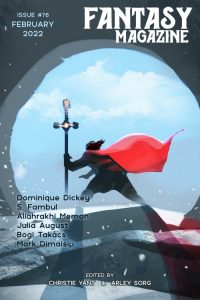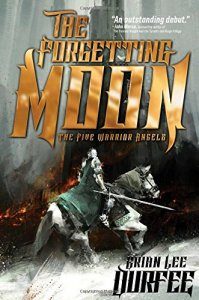Gary K. Wolfe reviews Ursula K. Le Guin
The most significant word in the title of Ursula K. Le Guin’s monumental two-volume short fiction retrospective from Small Beer Press is the least assuming one: ‘‘selected.’’ Le Guin, whose deservedly legendary 50-year career includes (according to the ISFDB) more than 130 stories, has chosen only 38 of them, which means that a lot gets left out, and Le Guin does not have a track record of writing many stories that deserve to get left out of anything. So she, and possibly her editors Gavin Grant & Kelly Link, have refrained from the more familiar and more commercial rubric ‘‘best of’’ in favor of the more austere ‘‘selected,’’ which leads to the obvious question: selected how and for what purpose? Le Guin provides some perfectly rational answers in the introduction to the first volume – no novellas because of the stories they would bump (hence classics such as ‘‘The World for World is Forest’’ and ‘‘Vaster Than Empires and More Slow’’ are missing), few stories linked closely to novels or story-suites (though we get a glimpse of Earthsea in ‘‘The Rule of Names’’), and some stories that Le Guin wanted ‘‘to bring back into the light.’’ She complains at the beginning of her introduction that she ‘‘begged people’’ to suggest stories and ‘‘nobody would’’ (though she admits that Grant & Link encouraged the inclusion of at least one). Well, asking your neighbors to name your favorite children for you won’t work, either, and for a good reason: they’re way more curious about what you think than about what they think. And learning how Le Guin views her own fiction may not be the major revelation of this collection – that lies in revisiting the stories themselves – but it’s still fascinating, because it suggests that the long and almost irresistible habit of deifying Le Guin in the realm of SF and fantasy just might, paradoxically, be another way of underestimating her achievement.
Let me explain. The earliest of the stories collected here dates from 1964, the latest from 2005 (although the stories are not arranged in chronological order, another wise decision on Le Guin’s part). The science fiction stories appear pretty much exclusively in Volume Two, while there are some non-SF stories there and some literary fantasies in Volume One. Not too surprisingly, the SF tales, especially the earlier ones, tend to come from venues like Amazing, Fantastic, Omni, New Dimensions, F&SF, and Asimov’s, while the less genre-like tales appeared in places like The Little Magazine and TriQuarterly. But the magazine that originally published more of these stories than any other is The New Yorker, the source of five stories, all dating from the 1980s (the same decade that magazine published its only Gene Wolfe story, and decades before its famous bet-hedging ‘‘science fiction’’ issue). Now The New Yorker may not be the imprimatur of canonization that it acts like it is – it’s certainly published its share of writers you’ve never heard of again – but it may have some capacity to shift the terms of discussion of a writer’s work, and the fact that Le Guin was nearly a regular there for a while (there were actually ten stories between 1979 and 1990) is suggestive. I’m not referring to the old ‘‘escaping the ghetto’’ canard, as though genre were a matter of bad urban planning, but to the question of how we might most fruitfully read her work in toto, which these volumes invite us to do. Sometime in the 1980s, I think, Le Guin, without ceasing to be one of the great SF writers, became one of the great American writers.
And her chosen pattern of organization for this collection, deliberately or not, reflects this by inviting us to look at her work more holistically than we are accustomed to. Any SF reader like myself will be delighted to see such acknowledged classics as ‘‘The Ones Who Walk Away from Omelas’’, or ‘‘Nine Lives’’, or ‘‘Buffalo Gals, Won’t You Come Out Tonight’’, but many may be surprised at the Orsinian or Oregonian tales (three from Searoad) that make up much of the first volume.
Revisiting these tales for the first time in years, and some for the first time entirely, I was struck by two that aren’t necessarily among those I’d have named if you’d asked me a month ago to name favorite Le Guin tales. One, ‘‘The Matter of Seggri’’, is pure Hainish SF, while the other, ‘‘Half Past Four’’, is not SF by any stretch. Yet each is radical in its own way, and maybe the space that can encompass these very different tales is the sort of space we ought to be talking about when we talk about Le Guin. ‘‘Half Past Four’’ is a kind of repertory fiction, in which four characters with the same names and roughly the same power relationships to each other are re-imagined in eight different stories, so that a sweet retarded stepson in one tale become a computer science student in another and a gay lover (of the stepfather from the earlier story) in another. It’s hardly a conventional story, and Le Guin’s abiding fascination with the fluid structures of family relationships is as evident here as it is in ‘‘The Matter of Seggri’’, a brilliant thought experiment on gender roles set on a planet in which female births vastly outnumber males, resulting in a society in which, as one narrator observes, the men have all the privilege and the women have all the power. The males are pampered and treasured, but at eleven they are yanked from their families and sent to live in a kind of nightmare theme park of violent sports and free sex (in fact, the women pay them), while the women maintain the society and exclusively receive higher education. Like many of Le Guin’s Hainish tales, it’s told through a series of observational reports and narratives over a lengthy time span, including a short story by one of the natives. (Another of the techniques which Le Guin pioneered is the use of multiple narrative voices, and in so thoroughly nailing the tone of anthropological field reports that it’s nearly become a convention in SF.)
So the most useful space in which to consider Le Guin’s fiction isn’t quite the fantastic, and isn’t quite not. Early in her career, she tells us, she felt torn between the dictates of modernist realism and the ‘‘limitless realms of the imagination.’’ Her imaginary middle-European country of Orsinia (the name echoes her own) proved to be a useful mediation, and perhaps incidentally helped pioneer a tradition of setting-based fantasy without supernatural figures or events (now fairly common in writers as diverse as K.J. Parker and Ellen Kushner). The first Orsinian tale here, ‘‘Brothers and Sisters’’, describes the plight of a number of young people seeking to find lives for themselves in a small village whose only options seem to be dangerous quarry work or unproductive farming. It introduces us to the Fabbre family, members of whom reappear in ‘‘A Week in the Country’’ (the best of the early Orsinian tales here) and ‘‘Unlocking the Air’’, in which the isolation of village life is replaced by the problems of survival under a repressive political regime. By the time we get to ‘‘Unlocking the Air’’, published more than a decade after the other Orsinian tales, the country has become a convenient backdrop for a story more concerned with Le Guin’s developing passion for investigating the nature of storytelling, with individual sections proclaiming themselves to be ‘‘a story,’’ a ‘‘history,’’ ‘‘a fairy tale,’’ or even ‘‘a stone.’’
The other setting most prominent in the first volume is Oregon, especially the rather bedraggled beach town of Klatsand from Searoad, which is as close as we get in Le Guin to a Sherwood Anderson-style portrait of a community through sketches of its inhabitants. The best of these is ‘‘Hand, Cup, Shell’’, in which an eager graduate assistant is dispatched to interview the aging widow of a famous educational theorist. The characters in the story are virtually all women, who come to realize how they have defined themselves and their perspectives through men, from the graduate student’s supervisor to the famous educationist himself. It’s one of the more understated but insightful expressions of the sophisticated feminism that marks so much of Le Guin’s fiction. But there are times when the Klatsand stories strain at the strictures of realism: in ‘‘Texts’’, a seasonal visitor begins to decipher messages, sometimes impenetrable, in everything from the line of seafoam on the beach to a lace tablecloth. Those constraints of realism are torn a little further in ‘‘Ether, OR’’, in which the town is again viewed through almost naturalistic sketches of its residents, but the town itself has a disarming habit of wandering all over the state. There’s a touch of the waggish humor here that we would also see in such stories as ‘‘The Flyers of Gy’’ or ‘‘The Silence of the Asonu’’ from Changing Planes. In general, Le Guin hasn’t gotten enough recognition for wit or humor, but it’s laced through these stories from the Barthelme-like high-rise climbing satire of ‘‘The Ascent of the North Face’’ to the meatheaded tourist who doesn’t realize what he’s seeing in Australia in ‘‘The First Contact with the Gorgonids’’.
Another favorite Le Guin technique, which also helps define that odd space which encompasses both the fantastic and the mundane, is what we might call the fantasy of perspective. As I said, she’s a pioneer in bringing the rhetoric of the anthropological field report into SF, and then shrewdly contrasting it with other narrative forms as in ‘‘The Matter of Seggri’’. But sometimes the shift in perspective is nearly the whole story. ‘‘Direction of the Road’’ may take place in Le Guin’s Oregon, but it’s an Oregon defamiliarized by being shown to us from the fully worked-out viewpoint of a tree. ‘‘Mazes’’, one of the most predictable of these tales, is basically a rat-in-a-maze tale from the intelligent rat’s viewpoint, while ‘‘The Wife’s Story’’, though more finely nuanced, does something similar with the werewolf tale. ‘‘The Author of the Acacia Seeds’’ takes this a step further by offering glimpses into the world of ‘‘therolinguistics,’’ or decodings of animal communication patterns, which not only offers us radically different perceptions of our own world, but which is already a classic in the emerging field of animal studies in SF. Le Guin also uses this technique to cast a slant angle on familiar tales from Genesis (‘‘She Unnames Them’’) to Sleeping Beauty (‘‘The Poacher’’). Point of view is crucial to many of these tales, even to one of my favorite SF pieces here, ‘‘The Shobies’ Story’’, in which an interplanetary crew undertakes the first experiment in instantaneous interstellar transportation, or ‘‘transilience,’’ and find that they aren’t all quite having the same experience.
After a while, though, the experience of reading any retrospective as excellent as the Selected Stories reduces you, if not to babbling, to just delighting in some of your favorites (‘‘Sur’’ is one of mine, among her shrewdest feminist satires and a fine adventure tale to boot), discovering some new treasures, and recognizing that a few old favorites might not stand up as well as you’d expected. There are dozens of essays to be written about Le Guin’s achievements in these stories, and dozens that have already been written, though none that quite encompass what we see here. Le Guin space isn’t a region of SF or fantasy, though both SF and fantasy are a region of Le Guin space, and it’s a space that encompasses us all.










Reading a story from Vol. 1, then one from Vol. 2, repeat. Nearly finished and I am unabashed in saying that Le Guin is my favorite living writer. This collection is remarkable.
Pingback:Locus Online Monitor » Classic Reprints, December